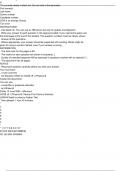Exam (elaborations)
OCR Higher GCSE Physics B Twenty First Century Science J259_04: Depth in physics (Higher Tier) question-paper june 2024
OCR Higher GCSE Physics B Twenty First Century Science J259_04: Depth in physics (Higher Tier) question-paper june 2024
[Show more]
Preview 3 out of 23 pages
Uploaded on
November 1, 2024
Number of pages
23
Written in
2024/2025
Type
Exam (elaborations)
Contains
Questions & answers
Institution
Ocr
Course
Ocr
$16.49
100% satisfaction guarantee
Immediately available after payment
Both online and in PDF
No strings attached
Oxford Cambridge and RSA




